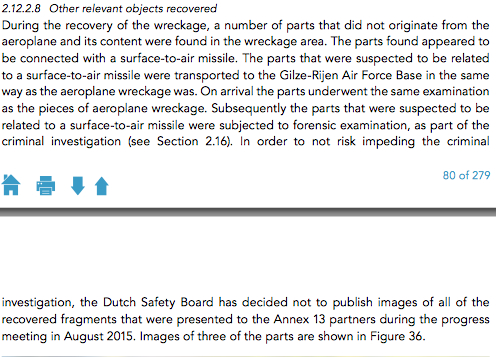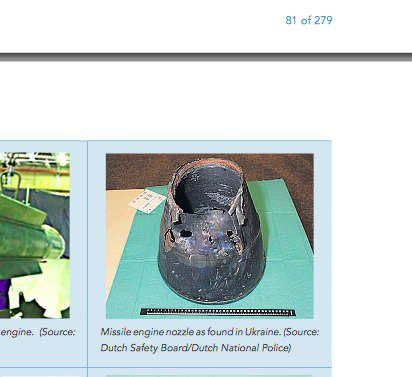It looks like you're using an Ad Blocker.
Please white-list or disable AboveTopSecret.com in your ad-blocking tool.
Thank you.
Some features of ATS will be disabled while you continue to use an ad-blocker.
share:
Malaysian Airlines Flight MH17 crashed as a result of a Russian-made 9M38 Buk missile, the Dutch Safety Board says.
The Dutch Safety Board presented its findings first to the victims' relatives before briefing reporters at the Gilze-Rijen military base in the Netherlands.
MH17 Ukraine disaster: Dutch report blames missile
The final MH17 report has been released by the Dutch Safety Board. A press conference was held at the airforce base Gilze-Rijen, Holland.
It was concluded that a BUK shot it down.
Here is the full report,
cdn.onderzoeksraad.nl...
a reply to: RogueWave
One of the other conclusions is that the Ukraine should have closed their airspace. They face criticism for not taking into account events of the weeks prior to the shootdown.
It is also claimed that the passengers didn't suffer much and lost unconsciousness quickly, however, I strongly doubt this.
One of the other conclusions is that the Ukraine should have closed their airspace. They face criticism for not taking into account events of the weeks prior to the shootdown.
It is also claimed that the passengers didn't suffer much and lost unconsciousness quickly, however, I strongly doubt this.
a reply to: RogueWave
So the reports concludes that :
And Dutch premier Mark Rutte would rather 'not speculate about the culprits' as stated in his latest press conference :
Rutte: Lessen trekken uit OVV-rapport MH17
Article in Dutch.
So the reports concludes that :
10. Weapon used
The aeroplane was struck by a 9N314M warhead as carried on a 9M38-series missile
and launched by a Buk surface-to-air missile system. This conclusion is based on the
combination of the following; the recorded sound peak, the damage pattern found
on the wreckage caused by the blast and the impact of fragments, the bow-tie and
cubic shaped fragments found in the cockpit and in the bodies of the crew members
in the cockpit, the injuries sustained by three crew members in the cockpit, the
analysis of the in-flight break-up, the analysis of the explosive residues and paint
found and the size and distinct, bow-tie, shape of some of the fragments.
11.
Missile flight paths
The area from which the possible flight paths of a 9N314M warhead carried on a
9M38-series missile as installed on the Buk surface-to-air missile system could have
commenced measures about 320 square kilometres in the east of Ukraine. Further
forensic research is required to determine the launch location. Such work falls outside
the mandate of the Dutch Safety Board, both in terms of Annex 13 and the Kingdom
Act ‘Dutch Safety Board’.
And Dutch premier Mark Rutte would rather 'not speculate about the culprits' as stated in his latest press conference :
Rutte: Lessen trekken uit OVV-rapport MH17
Article in Dutch.
Ii was conluded that the missile exploded within a few meter of the cockpit. I find this strange looking at the reconstruction of the plane. To me it
seems that the spread of shrapnell does not correspond to this; I would expect the holes to be much closer to one and other. I also would expect more
obvious blast damage.
I also don't get why the damage is concentrated on the part of the cockpit seating the pilots.
Regarding the outside elements recovered from the wreckage and bodies, there is actually relatively little evidence leading back to a BUK.
So out of 500 objects found, only 4 had a distinctive shape and quality that is similar to BUK shrapnell.
Quite marginal imo.
I also don't get why the damage is concentrated on the part of the cockpit seating the pilots.
Regarding the outside elements recovered from the wreckage and bodies, there is actually relatively little evidence leading back to a BUK.
Over 500 fragments were recovered from the wreckage of the aeroplane, the remains of the crew members and passengers. Many of the objects were identified as personal belongings, aeroplane parts or objects that originated from the ground after impact. In addition, many of the objects were metal fragments that were suspected to be high-energy objects, or parts of them. From the second group of objects, 72 fragments that were similar in size, mass and shape were further investigated.
43 of the 72 fragments were found to be made of unalloyed steel and four of these fragments, although heavily deformed and damaged, had distinctive shapes; cubic and in the form of a bow-tie
So out of 500 objects found, only 4 had a distinctive shape and quality that is similar to BUK shrapnell.
Quite marginal imo.
edit on 13-10-2015 by RogueWave because: (no reason given)
The reports photos aren't linkable, some pics already out there are displayed but not addressed, except to state it was found in Ukraine, satellite
images are google, lots of cgi "images" without links to their source.
This was interesting, page 80…
Oh, never mind, we can't capture text from this report, either.
So a screen shot of the smoking gun evidence, the missile itself.

See at the bottom where it says, we decided not to publish all the 'evidence'?
Below that, another screen capture of a missile engine nozzle just, "found in Ukraine".

This was interesting, page 80…
Oh, never mind, we can't capture text from this report, either.
So a screen shot of the smoking gun evidence, the missile itself.

See at the bottom where it says, we decided not to publish all the 'evidence'?
Below that, another screen capture of a missile engine nozzle just, "found in Ukraine".

a reply to: RogueWave
In your opinion as a munitions expert?
Ii was conluded that the missile exploded within a few meter of the cockpit. I find this strange looking at the reconstruction of the plane. To me it seems that the spread of shrapnell does not correspond to this; I would expect the holes to be much closer to one and other. I also would expect more obvious blast damage.
In your opinion as a munitions expert?
suspect timing of the reports release. suspect motives. insufficient transparency, details witheld. i call BS. part of operation 'demonize russia'.
phooey.
a reply to: DJW001
No you are trying to discredit my opinion based on nothing.
I am merely posting my opinion based on facts. I don't see how these 1000's of fragments that were positioned tightly around the warhead could spread so much in only 2 meters.
Why don't you respond to the content of my post?
No you are trying to discredit my opinion based on nothing.
I am merely posting my opinion based on facts. I don't see how these 1000's of fragments that were positioned tightly around the warhead could spread so much in only 2 meters.
Why don't you respond to the content of my post?
a reply to: DJW001
That is not an answer. The fact that the warhead contains high explosives doesn't explain why the spread is that big at that distance. The explosion is supposed to be symmetric all around so the differences in the angle of trajectory between individual pieces should be fairly small at two meters distance, imo.
That is not an answer. The fact that the warhead contains high explosives doesn't explain why the spread is that big at that distance. The explosion is supposed to be symmetric all around so the differences in the angle of trajectory between individual pieces should be fairly small at two meters distance, imo.
originally posted by: RogueWave
a reply to: DJW001
That is not an answer. The fact that the warhead contains high explosives doesn't explain why the spread is that big at that distance. The explosion is supposed to be symmetric all around so the differences in the angle of trajectory between individual pieces should be fairly small at two meters distance, imo.
The shrapnel is dispersed in two cones. The bases of the cones are nearly perpendicular to the missile's trajectory. This has been explained before.
new topics
-
Prisoner CNN helped free from Syrian prison was actually notorious Assad regime torturer: report
Mainstream News: 17 minutes ago -
Labour Plotting to Postpone May's Council Elections ?
Regional Politics: 1 hours ago -
Is this really what is going on?
General Conspiracies: 2 hours ago -
Russias War Against Religion in Ukraine
World War Three: 2 hours ago -
iPhone Microphone Being Accessed by Unknown App
The Gray Area: 5 hours ago -
Democrats send letter to Biden urging him to ratify Equal Rights Amendment
US Political Madness: 11 hours ago
top topics
-
iPhone Microphone Being Accessed by Unknown App
The Gray Area: 5 hours ago, 10 flags -
Is this really what is going on?
General Conspiracies: 2 hours ago, 7 flags -
Democrats send letter to Biden urging him to ratify Equal Rights Amendment
US Political Madness: 11 hours ago, 4 flags -
Russias War Against Religion in Ukraine
World War Three: 2 hours ago, 4 flags -
Labour Plotting to Postpone May's Council Elections ?
Regional Politics: 1 hours ago, 2 flags -
Prisoner CNN helped free from Syrian prison was actually notorious Assad regime torturer: report
Mainstream News: 17 minutes ago, 2 flags
active topics
-
Is this really what is going on?
General Conspiracies • 15 • : Ravenwatcher -
Only two Navy destroyers currently operational as fleet size hits record low
Military Projects • 32 • : Oldcarpy2 -
The Mystery Drones and Government Lies --- Master Thread
Political Conspiracies • 117 • : Guyfriday -
Drones everywhere in New Jersey ---and Elsewhere Master Thread
Aliens and UFOs • 181 • : matafuchs -
Prisoner CNN helped free from Syrian prison was actually notorious Assad regime torturer: report
Mainstream News • 0 • : xuenchen -
Russias War Against Religion in Ukraine
World War Three • 7 • : FlyersFan -
More Bad News for Labour and Rachel Reeves Stole Christmas from Working Families
Regional Politics • 10 • : Bilbous72 -
Labour Plotting to Postpone May's Council Elections ?
Regional Politics • 1 • : gortex -
Democrats send letter to Biden urging him to ratify Equal Rights Amendment
US Political Madness • 9 • : Texastruth2 -
Damascus has Fallen - Syrians are inside the presidential palace
Mainstream News • 106 • : Oldcarpy2
